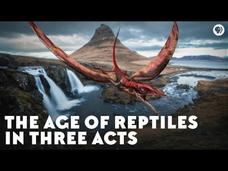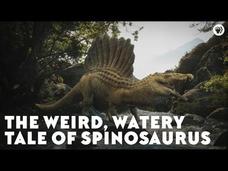Educreations
Dividing Using Friendly Numbers
Simplify division for young mathematicians by teaching them how to use friendly numbers when finding quotients. Three examples are presented in this instructional video that models the process of breaking large dividends into sums of...
Numberphile
Pi
Behind every number is a good story. Scholars learn how Archimedes tried to estimate the value of pi through inscribed and circumscribed figures. Viewers also see how they can use infinite series to find the value of pi by watching a...
Khan Academy
Decimal Place Value
Having a good number sense is key to understanding place value. This video clearly explains the place values that comprise a decimal number. It is a very straight forward presentation and would be appropriate for grades 3, 4, or 5. Sal...
Curated OER
Stem And Leaf Plots
Sal helps with data organization in this video, which focuses on stem and leaf plots. Clarifying that "this is just one of many, many, many ways to visualize data that you will run into in your mathematical or statistical futures," he...
Khan Academy
Writing a Number in Expanded Form
Understanding place value is a basic mathematics skill. This Khan Academy video shows students how to write the number 14,897 in the expanded form. He explains that the 7 in the ones place is the same as 7x1, the 9 in the tens place is...
Curated OER
Recognizing Divisibility
The divisibility rules are invaluable tools to possess. Sal teaches students to recognize divisibility using the divisibility rules. He explains why 380 is divisible by some numbers and not by others. Tip: Create a handout on the...
Curated OER
Scientific Notation 1
Scientific notation is defined and used to express the number 0.0000000003457. This concept is not as clearly defined as it could be, and is probably not suitable for those who have not had prior experience with the concept.
Socratica
Chemistry: What Is a Metal? (Metallic Bonds)
Metals offer unique properties thanks to the structure of their valence electrons. The Socratica chemistry playlist includes this video explaining what a metal is and the properties of metals. It focuses on their structures, features,...
Be Smart
Is This A New Species?!
Which makes a better name for a new species: Hermit Crab Caterpillar or Sir Leafs-a-Lot? Exploring a rainforest in Peru, the video helps viewers discover a unique species as part of a larger biology playlist. As scientists learn more...
Be Smart
How Many Species Are There?
Scientists discover over 15,000 new species each year. Despite studying life on our planet for all of human history, we still don't know how many species exist on Earth. An informative video from a biology playlist presents the dilemma,...
Be Smart
A Mammoth Undertaking: The Science of De-Extinction!
If scientists could use biotechnology to bring back extinct species, should it? A thought-provoking video explores the technical and ethical considerations of this question as part of a larger biology playlist. It explains what would be...
PBS
Why Triassic Animals Were Just the Weirdest
Normally when two species look similar, they are closely related. However, this doesn't seem to apply to the Triassic animals. Learn why these familiar looking animals are not actually related to today's animals. Viewers come to...
PBS
The Age of Reptiles in Three Acts
Reptiles survived the largest extinction event on the planet and then they grew into the most dominant class of the Mesozoic Era. They quickly evolved into giants on land, sea, and air. In an episode of the PBS Eons series viewers learn...
PBS
The Weird, Watery Tale of Spinosaurus
While scientists have know about dinosaurs that flew in the air, lived on land, and swam in the water, a episode from the PBS Eons series reveals recent discoveries of a dinosaur that was semi-aquatic—the first known semi-aquatic...
PBS
The Other Explosion You Should Know About
Scientists replace incorrect ideas when new evidence appears, but what happens when scientists reject the new evidence? Learn the story of the Avalon explosion and the scientists who resisted the fossils proving it existed as one part of...
Khan Academy
Vi and Sal Talk About the Mysteries of Benford's Law, Logarithms, Algebra II
Challenge your students to explain why this interesting mathematical law works! Sal, accompanied by Vi Hart, demonstrates BenfordÕs Law. They challenge the listeners to see if they can give an intuitive reason why this law fairly...
Be Smart
How The Toilet Changed History
In 2017, one in every three people still don't have access to a toilet. As part of a playlist on biology, an interesting video explains this global health topic. It describes society before toilets, disease research throughout history,...
Code.org
How Computers Work: Binary and Data
There are two types of people in the world: those who understand binary and those who do not. Pupils watch a video that describes how computers store information using binary code. They learn how programmers can encode text, images, and...
Be Smart
Why Do Disney Princesses All Look like Babies?
Could Disney be tricking people into caring about their characters? It seems the design of characters in recent years triggers our nurturing instincts. A video explains the science behind these instinctual habits—and why viewers are...
Khan Academy
What is Inside a DVD Player? (2 of 5)
Powered up! In a continuation of the series on DVD players, the second video explores the switch mode power supply unit. It also looks at the difference between AC and DC.
Khan Academy
What is Inside a Universal Remote Control?
Viewers get to see inside a universal remote control with a code library with a short video that explains the components and how they work together to provide convenience.
Crash Course
Electronic Computing: Crash Course Computer Science #2
What insect is the origin of the phrase computer bug? Scholars view a video to learn about the challenges with early computing efforts, including moths finding their way into mechanical relays. From vacuum tubes to transistors, the video...
Crash Course
How to Power Your Home: Crash Course Physics #35
Solve the mystery of how electricity works to power your home using an enlightening video lesson. An installment of the Crash Course physics series begins by describing how electricity reaches your home. The instruction includes an...
Crash Course
The Physics of Heat: Crash Course Physics #22
Compare and contrast the physics of heat flow with a well-designed video lesson. The 22nd installment of the Crash Course series is an overview of the physics of heat. After beginning with a discussion of thermal energy and heat, the...
Other popular searches
- Digital Storytelling
- Digital Photography
- Digital Clock
- Digital Media
- Digital Imaging
- Digital Art
- Digital Microscope
- Digital Video Camera
- Digital Self Portraits
- Digital and Analog Clocks
- Netiquette
- Digital Cameras

























